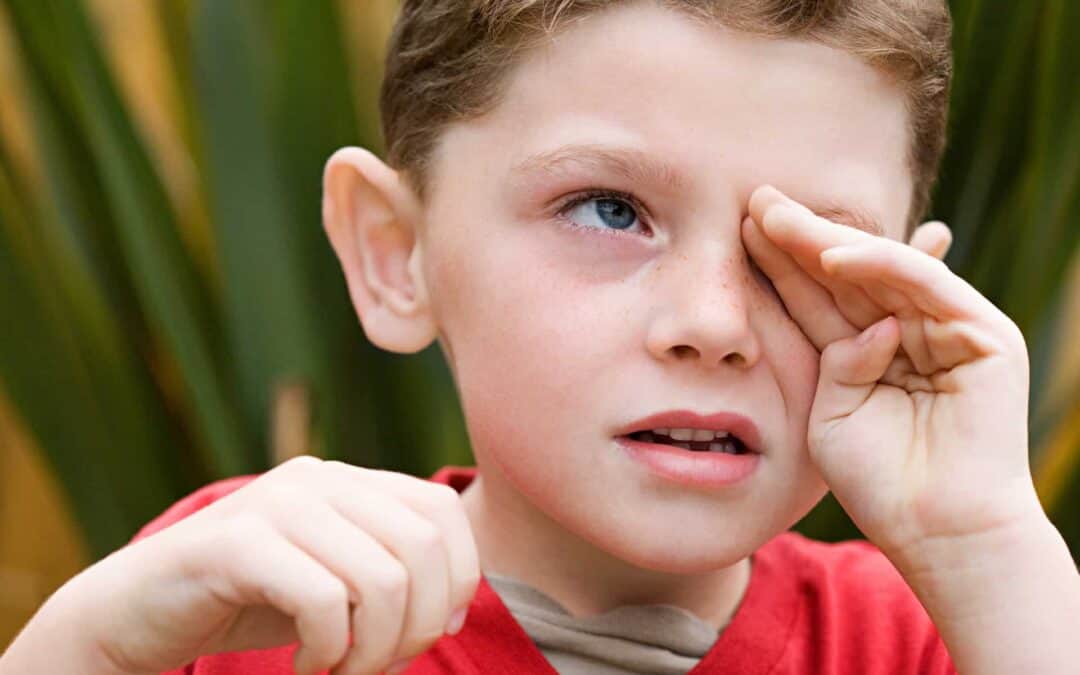How common are allergies among children?
Many children are affected by chronic allergies, which may become severe enough to affect their daily activities. However, children cannot always recognize what is wrong or explain their discomfort to family members or caregivers. The observation of specific behaviours and/or eye signs are useful in identifying eye allergies in children.
What are the signs/symptoms among children?
Children with ocular allergies often rub their eyes, blink forcefully and repeatedly or make rolling eye movements in response to the itchy sensation caused by allergies. They may complain that their eyes hurt, or they can’t see well. Their eyes may appear red and watery, similar to, but less severe than, pink eye. Mild swelling of the eyelids and a darkened discolouration of the skin under the eye may also occur. It is important to differentiate eye allergies from other forms of pink eye and eye inflammation by seeing a doctor of optometry. Severe eyelid swelling (causing the eye to remain closed) and/or a yellow or green discharge may signal a potentially serious eye infection and warrants more urgent attention.
What causes allergies among children?
It may be difficult to identify the cause of the allergies. As allergies tend to run in families, children are more likely to suffer allergy symptoms if they have a parent with allergies or asthma. Exposure to certain allergens can trigger a reaction in susceptible individuals. Common allergens include tree, grass and weed pollen; mold spores; dust mites; and cat, dog and rodent dander. Contact with plants (poison ivy, oak, sumac), certain foods (peanuts, milk) and insects may also trigger an allergic reaction of the skin, including the eyelids. Allergies may appear at the first encounter with a specific trigger or may develop after several exposures.
What are the treatments for allergies among children?
Minimizing or eliminating contact with the offending trigger, if it is known, is the most effective way to treat allergies. Make sure your children wash their hands and face frequently and resist touching or rubbing their eyes. Holding a clean face cloth soaked in ice-cold water over closed eyes for 5-10 minutes will reduce itchiness and bring some relief. Non-prescription artificial tear eye drops also will provide relief, especially if they are stored in the refrigerator to keep them cold. Repeating these simple procedures two to three times per day is recommended. Symptoms that persist despite these simple approaches warrant further evaluation by a doctor of optometry. A professional examination of the eye with a bio-microscope provides a magnified view of eye tissues and structures, allowing a doctor of optometry to identify the signs of an allergy and rule out other causes of eye irritation such as bacterial or viral infections. Once the eye allergy is confirmed, your doctor of optometry can recommend and prescribe specific allergy medications depending on the child’s age and the severity of the eye irritation. Non-prescription decongestant and antihistamine eye drops can provide temporary relief from redness and itching in older children, but they often cause a rebound reaction and worsening of symptoms if used longer than a few days. The use of these non-prescription allergy eye drops in children is not recommended unless professionally advised. Prescription allergy eye drops are more effective at reducing inflammation of ocular tissues and may be prescribed by your doctor of optometry for more severe eye allergies, even in young children. A doctor of optometry can advise you when it is useful to see an allergist for formal allergy tests.


